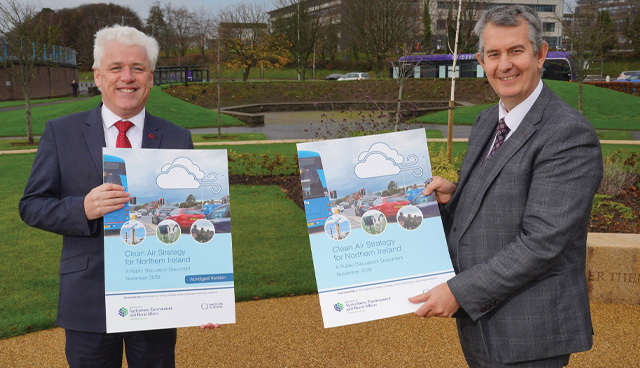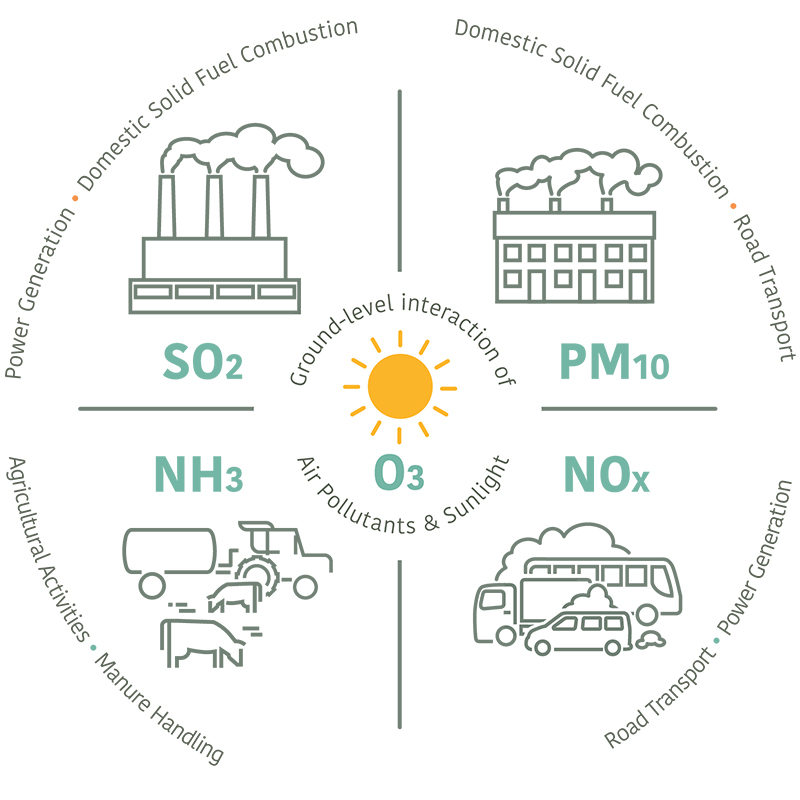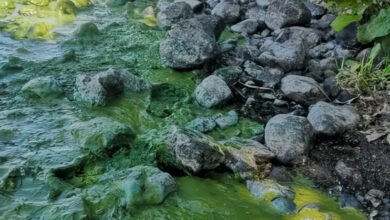A Clean Air Strategy for Northern Ireland

agendaNi outlines the key components of a discussion document set to enable the development of the first Clean Air Strategy for Northern Ireland.
A decade ago, Public Health England estimated that 553 deaths in over-25s in Northern Ireland were attributable to exposure to anthropogenic air pollution. For the UK as a whole, it’s estimated that annual UK deaths due to exposure to air pollution are between 28,000 and 36,000 people.
Greater climate awareness and increasing recognition that existing air quality policy and frameworks are not delivering the expected improvements in air quality in Northern Ireland are central to the development of the first Clean Air Strategy for Northern Ireland.
According to the British Heart Foundation, air pollution is associated with around 800 deaths in Northern Ireland annually and the charity estimates that over the next decade heart and circulatory disease deaths in Northern Ireland attributed to particulate matter air pollution could exceed 4,500 people.
In Northern Ireland, the biggest sources of particulate matter (PM), fine particles that, once in the air, are harmful to human health, are domestic wood and coal burning, industrial combustion and road transport. Increasingly, evidence is emerging to show that ammonia emissions (which are predominantly from agricultural activities) are a significant source of PM, as ammonia reacts with other air pollutants to form PM.
World Health Organisation (WHO) guidelines on air pollution state that: ‘By reducing air pollution levels, countries can reduce the burden of disease from stroke, heart disease, lung cancer, and both chronic and acute respiratory diseases, including asthma.”
The WHO estimates the cost of air pollution to economies in the WHO Europe region, with the figure for the United Kingdom being £61 billion. In May 2018, Public Health England published a report on the estimation of costs to the NHS and social care in England due to the health impacts of air pollution. The Department of Health (DoH) produced estimated burden costs for Northern Ireland using these figures and found that costs associated with diseases related to air pollution were around £1.5 million. When taking into account information on diseases where the evidence for an association with air pollution is currently less robust, then the costs could rise to nearly £5.4 million.
Projections of future costs by DoH indicate that in the period 2017-2025, the total cost to the HSC of air pollution in Northern Ireland is likely to be in the region of £55 million to £190 million, with the largest share of this expenditure occurring in secondary care.
However, the costs in all the other sectors combined is likely to exceed this spend. For the period 2017-2035, the combined cost is likely to be in the region of £182 million to £635 million. When all diseases are included, air pollution is expected to cause 84,000 new cases of disease in Northern Ireland between 2017 and 2035.
Transport
Nitrogen dioxide and particulate matter are the most common pollutants released from vehicles. From 2006 to 2016, the number of vehicles in Northern Ireland increased by 18 per cent, a higher rate than in England, Scotland and Wales and popularity of diesel vehicles is one of the reasons for the problems we now see with levels of nitrogen dioxide.
The Strategy consultation document sets out a range of considerations for future legislation and management but core to air quality management in transport is the reduction in vehicle pollutants through increasing levels of use of public transport, EV usage and active travel.

Home heating
Household emissions, usually through burning of materials, are more prominent in winter. Emissions from household heating present a significant problem for local air quality. 2011 census data showed that 2.6 per cent of households in Northern Ireland were classed as using solid fuels (wood and coal), the materials recognised as emitters of the highest levels of pollutants.
Research by NISRA through its Continuous Household Survey 2016/17 found that: “Some households burn solid fuels to heat their home, with this being the primary method of heating for 4 per cent of households, and a secondary method for 68 per cent of households.”
The consultation document states: “In an effort to reduce air pollution from household heating in Northern Ireland, serious consideration needs to be given to promoting behaviour change in individuals who are choosing to light an open fire, when this is not, of necessity, their primary heating source.”
The document analysis the potential benefits and challenges associated with extending smoke control areas, which can be declared by local authorities but which only cover a small area of Northern Ireland.
It proposes:
The number and extent of Smoke Control Areas in Northern Ireland should be reviewed;
- councils should consider declaring the entirety of urban centres as smoke control areas;
- legislation should be changed so that unauthorised fuels, such as bituminous coal, can no longer be bought in smoke control areas;
- legislation or controls should be introduced that prohibit the sale of unseasoned wood logs for home burning;
- information on smoke control should form part of councils’ annual local air quality management reporting.
Agriculture
Agriculture accounts for 1.4 per cent of Northern Ireland’s GVA and 2.6 per cent of total civil employment. However, it is also a major producer of air pollutants through ammonia. At high concentration, ammonia can negatively affect the health of plants and ecosystems.
Ammonia is not classed as a local air quality pollutant. This means that there are no limits or targets for ammonia in ambient air in the EU ambient air quality directives nor are there limits in ambient air for ammonia in the UK Air Quality Strategy and district councils do not measure levels of ammonia in urban centres.
Ammonia is, however, controlled under the Pollution Prevention and Control Regulations, which specify the amount of ammonia which may be emitted from industrial premises and agricultural installations exceeding certain thresholds.
For the UK, the EU targets are to reduce ammonia levels by 8 per cent by 2020 and then by 16 per cent by 2030, compared to 2005 levels. The devolved administrations will be expected to make their contribution to the UK’s target, and have fed into the UK’s National Air Pollution Control Programme, published in July 2019, which sets out the actions being undertaken to reduce the UK’s total emissions of pollutants.
In 2017, Northern Ireland’s ammonia emissions were 13 per cent greater than 1990 levels. DAERA have outlined plans to develop an Action Plan for Ammonia and the Department has set up an Ammonia Project Board, specifically tasked with examining the issues and evidence surrounding the ammonia problem in Northern Ireland.
Within the Strategy’s consultation, the critical question asked is: “Do you think that the process in place to address ammonia emissions in Northern Ireland is appropriate?”
Industry
The industrial sector accounts for a significant proportion of air pollution emissions in Northern Ireland and the sources include various types of activities ranging from large power stations to petrol station forecourts. Air pollution emissions from industry are, however, subject to strict regulation.
The discussion document asks: “Are there any industrial sectors or air pollutants that require new or further investigation?”
The discussion document forms part of a two-stage approach to developing the first Clean Air Strategy for Northern Ireland. The final Clean Air Strategy is set to undergo a further public consultation later in 2021.





